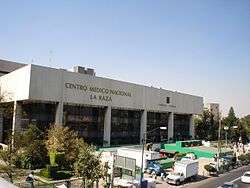Healthcare in Mexico

Healthcare in Mexico is provided by public institutions, private entities, or private physicians. Healthcare delivered by private organizations operates on the free market system and is available to those who can afford it. That is also the case of healthcare obtained from private physicians at their private office or clinic.
Public healthcare delivery, on the other hand, is accomplished by an elaborate provisioning and delivery system put in place by the federal government of Mexico. In 2009, Mexico instituted universal healthcare.[1] As of December 31, 2013, there were 4,466 hospitals in Mexico.[2]
History
Hospitals were established in Mexico in the early 16th century, including ones exclusively for Indians. Some were established by the crown, others by private endowment, but most by the Catholic Church. Bishop Vasco de Quiroga established hospital complexes in Michoacan in the sixteenth century. In Mexico City, conqueror Hernán Cortés established the Hospital de Jesús Nazareno for Indians, which still functions as a hospital.[3][4][5]
The Hospicio Cabañas in Guadalajara, Jalisco, Mexico, was founded in 1791. It is still functioning and is now a World Heritage Site. It is one of the oldest and largest hospital complexes in Latin America. The complex was founded by the Bishop of Guadalajara to combine the functions of a workhouse, hospital, orphanage, and almshouse.
The Mexican healthcare program Instituto Mexicano del Seguro Social was founded in 1943, during the presidency of Manuel Avila Camacho.[6] In the early 1990s, Mexico showed clear signs of having entered a transitional stage in the health of its population. Compared with 1940 or even 1970, 1990s Mexico had mortality patterns that more closely approximated those of developed societies.[7] By 2009, during the notorious swine flu pandemic, the World Health Organization director said that Mexico "gave the world a model of rapid and transparent reporting, aggressive control measures, and generous sharing of data and samples."
The Centers for Disease Control and Prevention's flu director, Nancy Cox, added that Mexico's response "impressed the entire world."[8]
Private healthcare delivery
While private hospitals account for two thirds of all hospitals in Mexico, with 2,988 institutions, less than 10% of the Mexican population has private insurance coverage. Care is paid mainly "out of pocket."[2]
Public healthcare delivery
Public healthcare has an elaborate provisioning and delivery system instituted by the Mexican government. It is provided to all Mexican citizens, as guaranteed by Article 4 of the Constitution. Public care is fully or partially subsidized by the federal government, depending upon the person's (Spanish: derechohabiente) employment status. All Mexican citizens are eligible for subsidized healthcare regardless of their work status via a system of health care facilities operating under the federal Secretariat of Health (formerly the Secretariat de Salubridad y Asistencia, or SSA) agency.
The Secretariat of Health's Seguro Popular offers coverage to Mexicans who do not have formal employment. The program currently covers over 55 million people.[9]
Employed citizens and their dependents, however, can use the program administered and operated by the Instituto Mexicano del Seguro Social (IMSS) (English: Mexican Social Security Institute). The IMSS program is a tripartite system funded equally by the employee, the private employer, and the federal government. There are 58 million people covered through IMSS.
The IMSS does not provide service to public employees, who instead are serviced by the Instituto de Seguridad y Servicios Sociales de los Trabajadores del Estado (ISSSTE) (English: Institute for Social Security and Services for State Workers), which attends to the health and social care needs of government employees: local, state, and federal government employees. There are nearly 13 million people covered by ISSSTE.[9]
The state governments of Mexico also provide health services independently of those that are provided by the federal government programs. In most states, the state government has established free or subsidized healthcare to all of its citizens.[10]
The Secretariat of Health is the largest public healthcare institution, operating 809 hospitals throughout the country. The IMSS grants hospital care and services to employed citizens and their dependents and had 279 hospitals affiliated to it. The ISSSTE grants hospital care and services to government employees and has 115 affiliated hospitals. The other 279 hospitals are affiliated with 9 government dependencies, including State Facilities, Secretariat of National Defense (Secretaria de Defensa Nacional), Mexican Navy (Secretaria de Marina), Petroleos Mexicanos (PEMEX), and the Red Cross (Cruz Roja).[11]
Hospitals are spread over a territory of 761,600 sq miles (1.973 million km²). Thus, the public hospital infrastructure relies on a vast network of small hospitals. Over 50% of public hospitals have fewer than 50 beds.
Health statistics

Aggregate health statistics for Mexico have improved greatly since the 1970s. However, Mexico lags well behind other Organisation for Economic Co-operation and Development countries in health status and availability.[12]
| 2012 | 2000 | Rank among OECD countries (2012) | |
|---|---|---|---|
| Life expectancy at birth (years) | 74.4 | 73.3 | 34 out of 34 |
| Life expectancy at birth, men (years) | 71.4 | 70.5 | 33 out of 34 |
| Life expectancy at birth, women (years) | 77.3 | 76.1 | 33 out of 34 |
| Life expectancy at 65, men (years) | 16.7 | 16.5 | 28 out of 34 |
| Life expectancy at 65, women (years) | 18.6 | 18.4 | 31 out of 34 |
| Mortality from cardiovascular diseases (age-standardized rates per 100,000) |
272.9 | 298.1 | 34 out of 34 |
| Mortality from cancer (age-standardized rates per 100,000) |
125.1 | 140.2 | 34 out of 34 |
| Tobacco consumption among adults (% daily smokers) |
11.8 | 12.9 | 34 out of 34 |
| Alcohol consumption among adults (liters per capita) |
5.7 | 5.1 | 32 out of 34 |
| Obesity rates among adults, measured | 32.4 | 24.2 | 2 out of 16 |
| Health expenditure as % of GDP | 6.2 | 5.0 | 32 out of 34 |
| Health expenditure per capita (US$ PPP) | 1048 | 497 | 33 out of 34 |
| Pharmaceutical expenditure per capita (US$ PPP) |
70 | 97 | 33 out of 33 |
| Pharmaceutical expenditure (% health expenditure) |
6.8 | 19.9 | 32 out of 33 |
| Public expenditure on health (% health expenditure) |
50.6 | 46.6 | 32 out of 34 |
| Out-of-pocket payments for health care (% health expenditure) |
45.2 | 50.9 | 1 out of 34 |
| Number of doctors (per 1000 population) | 2.2 | 1.6 | 31 out of 34 |
| Number of nurses (per 1000 population) | 2.6 | 2.2 | 33 out of 34 |
| Hospital beds (per 1000 population) | 1.6 | 1.8 | 34 out of 34 |
| Source: OECD Health Statistics, 2014[13] |
| Cause | Deaths (in thousands) |
Percent |
|---|---|---|
| Diabetes mellitus | 87.6 | 14.5% |
| Ischaemic heart disease | 76.0 | 12.6% |
| Stroke | 33.1 | 5.5% |
| Interpersonal violence | 32.7 | 5.4% |
| Cirrhosis of the liver | 25.0 | 4.1% |
| Chronic obstructive pulmonary disease | 23.3 | 3.8% |
| Lower respiratory infection | 20.8 | 3.4% |
| Hypertensive heart disease | 20.7 | 3.4% |
| Road injury | 15.0 | 2.5% |
| Kidney diseases | 13.9 | 2.3% |
| Source: Global Health Observatory data from the World Health Organization[13] |
During 2005, 45.5% of health spending was paid from public sources, comparable to the share of public spending in the United States but significantly below the OECD average. Private financing in Mexico is almost entirely in the form of out-of-pocket payments, as only 3.1% of total expenditures on health are funded through private health insurance.[12] Like every other major industrialized country (except the U.S.), government healthcare in Mexico is universal, making private programs' health insurance unnecessary except for private hospitals.
Some authorities have noted that while Mexico has some 3000 private hospitals, some private "hospitals" are hardly hospitals at all, since they have no laboratories, radiography equipment, or even nurses.[15] The remaining 1000 or so public hospitals account for the majority of hospital beds, and most private hospitals have fewer than 20 beds.
The child mortality rate up to five years was 17 per 1,000 live births in 2005, and Mexico has shown a faster acceleration to lower mortality rates than the US, Cuba, and Canada in the last 10 years. Also, 97% of the population had direct access to potable water and 80% to sanitation. Also in 2005, the incidence of human immunodeficiency virus/acquired immune deficiency syndrome (HIV/AIDS) in persons from 15 to 49 was 0.3%.[12] At 11,000 deaths/year as opposed to 22,000/year in the US, that represents a 44% higher per capita death rate than the United States.[16]
Affordability

In 1992, the New York Times reported that residents of the United States living near the Mexican border routinely crossed into Mexico for medical care.[17] Popular specialties included dentistry and plastic surgery. In 2007, the Washington Post reported that Mexican dentists charged 20-25% of US prices,[18] and other procedures typically cost a third of the US price.[17]
Universal health care
On December 1, 2006, the Mexican government created the Health Insurance for a New Generation (also called "Life Insurance for Babies").[19][20][21] It was followed by a February 16, 2009, announcement by President Felipe Calderon, who stated that at the current rate, Mexico would have universal health coverage by 2011,[22] and a May 28, 2009 announcement of universal coverage for pregnant women.[23] In August 2012 Mexico installed a universal healthcare system.[1]
Social determinants
Social determinants of health in Mexico are factors that influence the status of health among certain populations in Mexico. They are circumstances in which people grow, live, work, and age and the systems put in place to deal with illnesses. In Mexico, health inequality in the population is influenced by such social factors. In the past decade, Mexico has witnessed immense progress within its health care system that has allowed for greater access to health care and a decrease in mortality rate, but there are still various health inequalities caused by social factors.
References
- 1 2 "Mexico achieves universal health coverage, enrolls 52.6 million people in less than a decade". Harvard School of Public Health. 2012-08-15. Retrieved 2013-09-16.
- 1 2 Global Health Intelligence, "Global Health Intelligence". Retrieved 19 January 2015.
- ↑ David Howard, The Royal Indian Hospital of Mexico City, Tempe: Arizona State University Center for Latin American Studies, Special Studies 20, 1979.
- ↑ Carmen Venegas Ramírez, Régimen hospitalario para indios en la Nueva España. Mexico 1973.
- ↑ Josefina Muriel, Hospitales de la Nueva España. 2 vols. Mexico 1956-60.
- ↑ Mexico's health care lures Americans. Chris Hawley. USA Today. 9/1/2009. Retrieved 24 August 2012.
- ↑ Health Care and Social Security. Tim L. Merrill and Ramón Miró, editors. Mexico: A Country Study. Washington: GPO for the Library of Congress, 1996. (Quoted as: "Source: U.S. Library of Congress.") Retrieved 24 August 2012.
- ↑ Mexico Wins Praise for Swine Flu Response. Maria Cheng (London) and Vicente Panetta (Buenos Aires). Associated Press. Retrieved 4 July 2009.
- 1 2 Mexican National Statistics Institute, "INEGI". Retrieved 22 January 2015.
- ↑ Quienes Somos. Archived 2009-07-21 at the Wayback Machine. Secretaria de Salud. Federal Government of Mexico. Retrieved 4 July 2009.
- ↑ National Health Information System, "SINAIS". Retrieved 1 June 2014.
- 1 2 3 Country profile: Mexico. Library of Congress Federal Research Division (July 2008).
- 1 2 3 OECD Health Statistics 2014: How does Mexico compare?, OECD Health Statistics 2014.
- ↑ Global Health Observatory data: General health statistical profile: Mexico, World Health Organization (last updated January 2015).
- ↑ Health care quality improvement in Mexico: challenges, opportunities, and progress. Enrique Ruelas. Baylor University Medical Center Proceedings. (Proc (Bayl Univ Med Cent). 2002 July; 15(3): 319–322.) July 2002. PMC 1276627 Retrieved 10 July 2009.
- ↑ Country Comparison :: HIV/AIDS – deaths – Mexico. U.S. Central Intelligence Agency. World Fact Book. Retrieved 24 August 2012.
- 1 2 Philip J. Hilts, Quality and Low Cost of Medical Care Lure Americans to Mexican Doctors, New York Times (November 23, 1992).
- ↑ Manuel Roig-Franzia, Discount Dentistry, South of The Border, Washington Post (June 18, 2007).
- ↑ Message to the Nation from the President of Mexico, Felipe Calderón Hinojosa, on the occasion of his first State of the Union Address. Mexican Federal Government. Office of the Presidency. 2006. Retrieved 4 July 2009.
- ↑ President Calderón during First National Week of Affiliation to Medical Insurance for a New Generation. Federal Government of Mexico. Office of the Presidency. 2006. Retrieved 4 July 2009.
- ↑ President Calderón at Launching of Affiliation to Medical Insurance for a New Generation. Federal Government of Mexico. Office of the Presidency. 2006. Retrieved 4 July 2009.
- ↑ Mexico to Achieve Universal Health Coverage by 2011. Federal Government of Mexico. Office of the Presidency. 2006. Retrieved 4 July 2009.
- ↑ International Women's Day. Federal Government of Mexico. Office of the Presidency. 2006. Retrieved 4 July 2009.